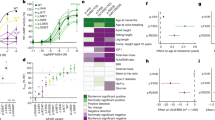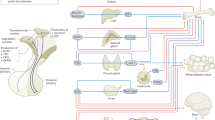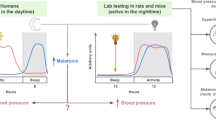Abstract
THERE is evidence to suggest the existence of a pineal gland substance which moderates growth both in man and the rat. In man, non-parenchymal tumours, such as gliomas or teratomas which result in destructive lesions of the pineal gland, are associated with precocious puberty1,2 and it has been hypothesized that such lesions prevent the pineal from secreting gonadal2 and growth3,4 inhibitory factors. It was recently reported5 that the ability of the pineal gland to influence both growth and gonadal development may be due to two distinct physiological mechanisms. Rats which are blinded or kept in constant darkness show reduced body weight4,5, reduced tibeal length4, and reduced accessory organ weights4 as well as retarded puberty2,5,6. Blinded rats were also found4 to have significantly reduced pituitary gland stores of growth hormone. The effects of blinding or constant darkness on growth and growth hormone stores were abolished by pinealectomy4,7—a procedure also found8 to increase the gain of body weight in otherwise normal rats. Pinealectomy has also been reported to result in increased growth of experimental tumours in rats9. The observation10 of a diurnal fluctuation in the secretion of growth hormone in the rat further suggests that the lighting regime can modify this release. When lighting is reduced, concentrations of the pineal hormone melatonin (N-acetyl-o-methylserotonin) are increased because it is synthesized within the pineal gland from serotonin (5-hydroxytryptamine) by the action of the enzymes serotonin-N-acetyltransferase and hydroxyindole-o-methyltransferase, both of which exhibit their highest activities in the absence of light11,12. The fact that the conditions favouring high melatonin production correlate with those which cause reduced growth (and the other way round) suggests that melatonin has an inhibitory role in growth hormone secretory mechanisms. Collu et al.13 demonstrated that intraventricular injections of serotonin stimulate secretion of growth hormone in the rat, and they proposed that in this animal secretion of growth hormone is controlled through serotoninergic pathways. Serotonin has also been implicated as the stimulus for secretion of growth hormone after the onset of slow-wave (non-rapid eye movement, NREM) sleep in normal humans14. It thus seems that serotonin and its pineal derivative, melatonin, may have opposing effects on the secretion of growth hormone. We describe here experiments which support this contention.
This is a preview of subscription content, access via your institution
Access options
Subscribe to this journal
Receive 51 print issues and online access
$199.00 per year
only $3.90 per issue
Buy this article
- Purchase on Springer Link
- Instant access to full article PDF
Prices may be subject to local taxes which are calculated during checkout
Similar content being viewed by others
References
Kitay, J. I., and Altschule, M. D., in The Pineal Gland (Harvard University Press, Cambridge, 1954).
Cohen, R. A., Wurtman, R. J., Axelrod, S., and Snyder, S., Ann. Intern. Med., 61, 1144 (1964).
Wiener, H., New York State J. Med., 68, 1019 (1968).
Sorrentino, S., Schalch, D. S., and Reiter, R. J., in Growth and Growth Hormone (edit. by Pecile, A., and Muller, E. E.) (Excerpta Medica, Amsterdam, 1972).
Osman, P., Welschen, R. W., and Moll, J., Neuroendocrinology, 10, 121 (1972).
Wurtman, R. J., Axelrod, J., and Kelly, D. E., in The Pineal (Academic Press, New York, 1968).
Eayrs, S. T., and Ireland, K. F., J. Endocrinol., 25, 1470 (1949).
Malm, O. J., Skaug, O. E., and Lingjoerde, P., Acta Endocrinol., 30, 22 (1959).
Rodin, A. E., Cancer Res., 23, 1545 (1963).
Muller, E. E., Giustina, G., Miedico, D., Pecile, A., Cocchi, D., and King, F. W., Proc. Soc. Exp. Biol. Med., 135, 934 (1970).
Klein, D. C., and Weller, J. L., Science, 196, 1093 (1970); 177, 532 (1972).
Wurtman, R. J., Axelrod, J., and Phillips, L. S., Science, 142, 1071 (1963).
Collu, R., Fraschini, F., Visconti, P., and Martini, L., Endocrinology, 90, 1231 (1972).
Laborit, H., Res. Commun. Chem. Pathol. Pharmacol., 3, 51 (1972).
Okada, F., Saito, Y., Fujieda, T., and Yamashita, I., Nature, 238, 355 (1972).
Anton-Tay, F., and Wurtman, R. J., Nature, 221, 474 (1969).
Stone, C. A., Wenger, H. C., Ludden, C. T., Starvoski, J. M., and Ross, C. A., J. Pharmacol. Exp. Ther., 131, 73 (1961).
Davidson, J., Sjoerdsma, A., Loomis, L. N., and Udenfriend, S., J. Clin. Invest., 36, 1594 (1957).
Sassin, J. F., Parker, D. C., Mace, J. W., Gotlin, R. W., Johnson, L. C., and Rossmann, L. G., Science, 106, 513 (1969).
Krieger, D. T., and Glick, S., J. Clin. Endocrinol. Metab., 33, 847 (1971).
Thompson, D. A., in Growth and Form (Cambridge University Press, 1942).
Tanner, J. M., in Growth at Adolescence, second ed. (Blackwell, Oxford, 1962).
Starr, K. W., in Progress in Clinical Cancer (edit. by Ariel, I. M.), IV (Grune and Stratton, New York, London, 1970).
Wurtman, R. J., Axelrod, J., and Potter, L. T., J. Pharmacol. Exp. Ther., 143, 314 (1964).
Smythe, G. A., and Lazarus, L., Endocrinology (in the press).
Anton-Tay, F., Chou, C., Anton, S., and Wurtman, R. J., Science, 162, 277 (1968).
Author information
Authors and Affiliations
Rights and permissions
About this article
Cite this article
SMYTHE, G., LAZARUS, L. Growth Hormone Regulation by Melatonin and Serotonin. Nature 244, 230–231 (1973). https://doi.org/10.1038/244230a0
Received:
Revised:
Published:
Issue Date:
DOI: https://doi.org/10.1038/244230a0
This article is cited by
-
Histological and transcriptomic analysis of adipose and muscle of dairy calves supplemented with 5-hydroxytryptophan
Scientific Reports (2021)
-
Melatonin – Known and Novel Areas of Clinical Application
Neuroscience and Behavioral Physiology (2019)
-
Light, blindness and endocrine secretions
Journal of Endocrinological Investigation (1999)
-
Twenty-four hour melatonin pattern in acromegaly: Effect of acute octreotide administration
Journal of Endocrinological Investigation (1997)
-
Normal plasma insulin-like growth factor I levels and impaired final stature in adult blind subjects
Journal of Endocrinological Investigation (1994)
Comments
By submitting a comment you agree to abide by our Terms and Community Guidelines. If you find something abusive or that does not comply with our terms or guidelines please flag it as inappropriate.



